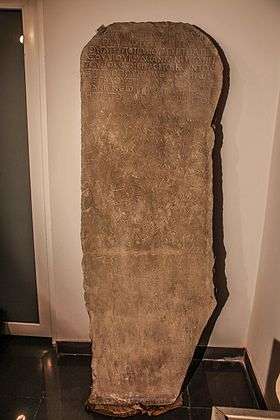Armazi stele of Serapit
The Armazi stele of Serapit (Georgian: სერაფიტას არმაზის სტელა) or Armazi bilingual (Georgian: არმაზის ბილინგვა) is a stele with bilingual inscriptions written in Ancient Greek and Aramaic found in 1940, at Armazi, near Mtskheta, in the ancient capital of the Kingdom of Iberia. The stele memorialises a short-lived Georgian princess named Serapit.[1] The inscriptions mention Georgian monarchs, Pharnavaz I of Iberia and Pharasmanes II of Iberia, and other members of aristocracy. The inscriptions are dated 150 AD.[2][3]
Inscriptions
Ancient Greek inscription
| “ |
Serapeitis, daughter of Zeouach the Younger, pitiaxes, wife of Iodmanganos, son of Publicius Agrippa, pitiaxes, who won many battles as epitropos of the great king of the Iberians, Xepharnougos. She died, younger than twenty-one years, who had inimitable beauty.[2] |
” |
Aramaic inscription
| “ |
I am Serapit, daughter of Zewah the Younger, pitiaxes of King Pharasmanes, wife of Yodmangan the victorious and winner of many victories, master of the court of King Xepharnougos and the son of Agrippa, master of the court of King Pharasmanes, victorious over the mighty, which Pharnavaz could not accomplish. Serapit was so fine and beautiful that no one was her equal in beauty. And she died in her twenty-first year.[2] |
” |
References
- ↑ Lang, p. 4
- 1 2 3 Rapp, p. 216
- ↑ Lang, p. 5
Bibliography
- Stephen H. Rapp Jr (2014) The Sasanian World through Georgian Eyes: Caucasia and the Iranian Commonwealth in Late Antique Georgian Literature
- David Marshall Lang (1966) Landmarks in Georgian Literature
Further reading
